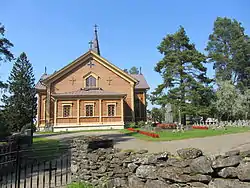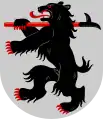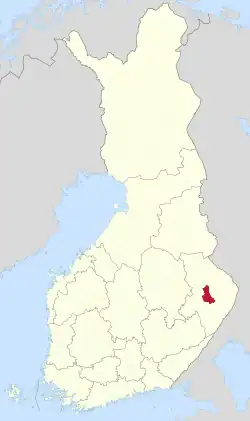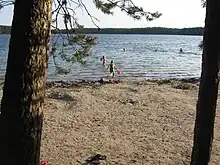Kontiolahti
Kontiolax | |
|---|---|
Municipality | |
| Kontiolahden kunta Kontiolax kommun | |
 Kontiolahti Church in July 2012 | |
 Coat of arms | |
 Location of Kontiolahti in Finland | |
| Coordinates: 62°46′N 029°51′E / 62.767°N 29.850°E | |
| Country | |
| Region | North Karelia |
| Sub-region | Joensuu |
| Charter | 1873 |
| Government | |
| • Municipal manager | Jere Penttilä |
| Area (2018-01-01)[1] | |
| • Total | 1,029.82 km2 (397.62 sq mi) |
| • Land | 799.82 km2 (308.81 sq mi) |
| • Water | 230.1 km2 (88.8 sq mi) |
| • Rank | 101st largest in Finland |
| Population (2023-09-30)[2] | |
| • Total | 15,121 |
| • Rank | 73rd largest in Finland |
| • Density | 18.91/km2 (49.0/sq mi) |
| Population by native language | |
| • Finnish | 97.7% (official) |
| • Swedish | 0.1% |
| • Others | 2.3% |
| Population by age | |
| • 0 to 14 | 21.1% |
| • 15 to 64 | 61% |
| • 65 or older | 17.9% |
| Time zone | UTC+02:00 (EET) |
| • Summer (DST) | UTC+03:00 (EEST) |
| Website | www.kontiolahti.fi |
Kontiolahti (Swedish: Kontiolax; literally meaning "bear bay") is a municipality of Finland. It is located in the North Karelia region, about 20 kilometres (12 mi) north of Joensuu. The municipality has a population of 15,121 (30 September 2023)[2] and covers an area of 1,029.82 square kilometres (397.62 sq mi) of which 230.1 km2 (88.8 sq mi) is water.[1] The population density is 18.91 inhabitants per square kilometre (49.0/sq mi). Neighbouring municipalities are Joensuu, Juuka, Lieksa, Liperi and Polvijärvi. The municipality is unilingually Finnish.
Coat of arms of the municipality of Kontiolahti is a canting arms; the log driving pike pole, which the bear carries in the picture, refers to the importance of forestry in the region's economy. The coat of arms was designed by Aarno Liuksiala and approved by the Kontiolahti Municipal Council at its meeting on December 8, 1952. The coat of arms was approved for use by the Ministry of the Interior on February 27, 1953.[5][6]
Kontiolahti hosted the Biathlon World Championships in 1990, 1999 and 2015.[7]
History
Kontiolahti originally belonged to the parish of Liperi. It became an independent municipality in 1873. The flood nuisance of Lake Höytiäinen and the desire for water abandonment inspired residents to try to build a canal to lower the water level, but the dam broke uncontrollably in 1859, and the landscape changed dramatically.[8] After World War II, the Ruskeala's migrants were stationed in Kontiolahti.
Geography

Kontiolahti has 183 lakes, and water bodies cover 22.3 percent (230 km2) of the municipality's surface area. The largest of them are Lake Höytiäinen, Lake Kangasvesi and Lake Herajärvi.[9] There are 11 Natura sites in all or part of Kontiolahti: Teerisaari-Sisuslahti, Soikkeli Forest, Pöllönvaara-Kruununkangas, Paihola Forest, Kolvananuuro and surrounding areas, Koli National Park, Jouhteninen, Huurunlampi-Sammakkolampi-Huurunrinne and Huuhkajanvaara.[10]
Villages
Transport
Joensuu Region's Public Transport (Joensuun seudun joukkoliikenne; JOJO) is responsible for local and school traffic in the Kontiolahti area.[12] Kontiolahti also has a railway station,[13] which, however, no longer has passenger traffic. Highway 6 passes through the municipality.[14][11]
Culture
Libraries
Municipal library services are provided by the Kontiolahti Library, the Lehmo Library, and Runo-Antti, the bookmobile of Kontiolahti and Eno.[15][16][17][18]
Food
In the 1980s, Kontiolahti's parish dishes were named "shoemaker's roast" (suutarinpaisti) and stockfish soup.[19]
Notable people
- Tero Mustonen (born 1976 or 1977), environmental leader, scholar, scientist, and fisherman
- Jukka Nevalainen (born 1978), former drummer of Nightwish
- Markku Pölönen (born 1957), film director, screenwriter, editor and owner of film production company Suomen Filmiteollisuus
- Antti Puhakka (1816–1893), national romantic poet
See also
References
- 1 2 "Area of Finnish Municipalities 1.1.2018" (PDF). National Land Survey of Finland. Retrieved 30 January 2018.
- 1 2 "Preliminary population statistics 2023, September". StatFin. Statistics Finland. Retrieved 26 October 2023.
- ↑ "Demographic Structure by area as of 31 December 2022". Statistics Finland's PX-Web databases. Statistics Finland. Retrieved 6 September 2023.
- ↑ "Population according to age (1-year) and sex by area and the regional division of each statistical reference year, 2003–2020". StatFin. Statistics Finland. Retrieved 2 May 2021.
- ↑ Suomen kunnallisvaakunat (in Finnish). Suomen Kunnallisliitto. 1982. p. 139. ISBN 951-773-085-3.
- ↑ "Sisäasiainministeriön vahvistamat kaupunkien, kauppaloiden ja kuntien vaakunat 1949-1995 I:10 Kontiolahti". Kansallisarkiston digitaaliarkisto (in Finnish). Retrieved August 8, 2021.
- ↑ ""Kontiolahden Urheilijat" [Kontiolahti Sports Club]. Kontiolahti: Kontiolahden Urheilijat r.y. Archived from the original on 12 November 2013. Retrieved 17 November 2013.
- ↑ "Historian Havinaa" (in Finnish). Kontiolahti. Archived from the original on December 14, 2017. Retrieved August 8, 2021.
- ↑ Kontiolahden järvet – Järviwiki (in Finnish)
- ↑ Tutustu Natura 2000 -kohteisiin kunnittain – Ympäristö.fi (in Finnish)
- 1 2 Kylät Pohjois-Karjalassa – Kylät.fi (in Finnish)
- ↑ JOJO – Official Site (in English)
- ↑ YLE: Koti rautatien varrella (in Finnish)
- ↑ Maantien 15716 kevyen liikenteen väylä välillä Urheilukentäntie – Tuppihaantie, Kontiolahti – Väylä (in Finnish)
- ↑ "Kontiolahden kirjasto – Ota yhteyttä". kirjastot.fi (in Finnish). Retrieved August 8, 2021.
- ↑ "Kontiolahden kirjasto" (in Finnish). Vaara-kirjastot. Retrieved August 8, 2021.
- ↑ "Lehmon kirjasto" (in Finnish). Vaara-kirjastot. Retrieved August 8, 2021.
- ↑ "Kontiolahden ja Enon kirjastoauto". kirjastot.fi (in Finnish). Archived from the original on May 21, 2021. Retrieved August 8, 2021.
- ↑ Jaakko Kolmonen (1988). Kotomaamme ruoka-aitta: Suomen, Karjalan ja Petsamon pitäjäruoat (in Finnish). Helsinki: Patakolmonen. pp. 122–123. ISBN 951-96047-3-1.
External links
 Media related to Kontiolahti at Wikimedia Commons
Media related to Kontiolahti at Wikimedia Commons- Municipality of Kontiolahti – Official website, finnish, english, germany and russian
- Sirnihta Holiday Villa's
